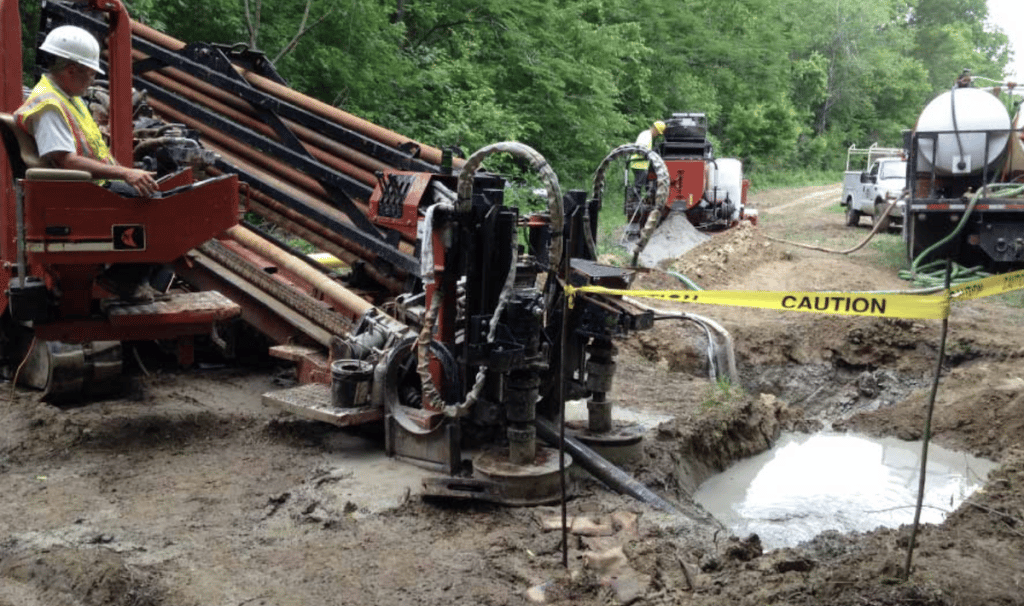Horizontal directional drilling rigs are large pieces of equipment, with a lot of moving parts. Like any piece of machinery, there is room for mishaps and injury. If you’re working on or nearby a drilling rig, you need to learn the risks and safety requirements. We’ll go through a checklist for avoiding common risks and concerns around HDD boring.
Clothing
What you wear is very important when working around machinery, and the same goes for HDD drilling rigs.
Ears and Eye Protection
Your ears and eyes are both very sensitive organs, and you should keep them safe. With any machinery you’ll need to wear safety glasses to prevent any potential airborne object from hitting you in the eye. Drilling rigs in general are quite loud, and if you need to raise your voice to hear someone barely a metre away from you, this is a strong indicator that you need to wear ear muffs.
Work Gloves
If you’re handling directional drilling equipment or drill rods you’re going to notice they have a little sharp bit all over them. This is from them being constantly tightened and untightened. Prevent cutting the palm of your hand open by using proper work gloves.
Hard Hat
Moving parts gives potential to falling parts. Keep a hard hat on just in case something breaks and falls towards your head, it’ll still hurt but not as much as it would without a hard hat on.
Steel Cap Boots
There is always the potential to drop tools and equipment on your feet. If you want to keep your toes safe, wear some steel cap boots.
High Visibility Clothing
Some job sites are on the side of the road or beside a train line, so it’s paramount you wear high visibility clothes. But even on normal work sites, it’s a good idea to keep them on, as it allows the drill rig operator to have a clear visual of where everyone is.
No Loose-Fitting Clothes
The spinning drilling rods and cables have the potential to grab. This is an extremely dangerous situation, as the power behind the rig is enough to kill someone if the emergency stop button isn’t pressed fast enough. For this reason you shouldn’t be wearing any loose-fitting clothes.
No Jewellery
Jewellery, and especially loose-fitting jewellery, shouldn’t be worn on construction sites. There usually aren’t any rules against rings, but it’s not recommended wearing them. If a ring is crushed or somehow hooked, it can lead to severe degloving injuries. It’s best to take them off before work.
Service Locating
Service locating is another area that should never be skipped over with safety. Radar locating is one method of service locating, and the other is non-destructive drilling, either done with a hand auger or with a vacuum truck.
Whether you’re the operator, assistant, or working with the drillers, ensure locating work has been completed. Don’t just take somebody’s word for it, either check with the locator or check the ground for any services that have been marked.
Risk Assessments
Sometimes a quick run-through of the potential hazards can stop dangerous situations from happening.
Check the Rig
Do a visual check of the rig before work is commenced. If you notice something going on with the equipment, notify the operator, or stop the equipment if you are operating it.
Assess Site Working Conditions
If you’re working on the drilling rig, make sure you have enough working space. Many times there will be other people there, so it’s best to delineate your working area to allow for room. You will be working with large equipment and it’s important that you have enough space to operate it safely.
If you aren’t working on the rig, allow the workers their room and space, then when they give the all clear you can move closer. Good site coordination and communication ensure a cohesive and smooth running work site.
Don’t Touch the Spinning Rod
Never touch the rods unless you’ve been instructed to. As mentioned before, there is a lot of power behind the engine that turns the rods, and it can lead to injury or even be fatal. Generally though, if you’re not there to specifically work on the drilling rig, you shouldn’t need to touch the rods.
Know where the Emergency Stop Button is
Everyone working nearby the drilling rig should know where the emergency stop buttons are. The operator should always let everybody know before work commences.
Be Mindful of Undetected Services
Even with careful planning and locating work, there may be that one service that slipped between the gaps. If a service is hit, and either pieces of it come up in cuttings, ensure the drilling work is stopped immediately. Once a service has been broken, it can be a big hassle with site managers and supervisors, potentially costing a lot of money, and in some rare cases injury. Keep calm and go through necessary steps given to you by the supervisors.
